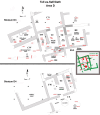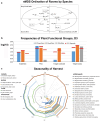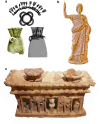Plant-related Philistine ritual practices at biblical Gath
- PMID: 38347005
- PMCID: PMC10861565
- DOI: 10.1038/s41598-024-52974-9
Plant-related Philistine ritual practices at biblical Gath
Abstract
The Philistine culture (Iron Age, ca. 1200-604 BCE) profoundly impacted the southern Levant's cultural history, agronomy, and dietary customs. Nevertheless, our knowledge of the Philistines' cultic praxis and deities, is limited and uncertain. Here, we combine archaeological data with a meticulous study of plant use at two successive temples at Tell eṣ-Ṣâfī/Gath. We provide a list of the plants used, their time of harvest, mode of offering, and possible symbolism. Analysis of the temples' macrobotanical (seed and fruits) plant assemblage reveals the offerings; that the inception date for rites was early spring; and sheds light on the date of the final utilization of the temples (late summer/early fall). Besides food crops, we note the earliest cultic use of chaste tree (Vitex agnus-castus), crown daisy (Glebionis coronaria), and scabious (Lomelosia argentea). These wide-spread Mediterranean plants were known so far only in later cults-of early Greek deities, such as Hera, Artemis, Demeter, and Asclepios. We discuss the data as reflecting that the Philistine religion relied on the magic and power of nature, such as fresh water and seasonality, which influence human life, health, and activity. In sum, our results offer novel insights into the culture of the Philistines.
© 2024. The Author(s).
Conflict of interest statement
The authors declare no competing interests.
Figures







Similar articles
-
Identification of New Diterpenes as Putative Marker Compounds Distinguishing Agnus Castus Fruit (Chaste Tree) from Shrub Chaste Tree Fruit (Viticis Fructus).Planta Med. 2016 Jan;82(1-2):147-53. doi: 10.1055/s-0035-1558089. Epub 2016 Jan 12. Planta Med. 2016. PMID: 26756820
-
Colonic Obstruction Secondary to Phytobezoar Caused by Vitex Agnus-Castus Seeds: A Case Report.J Coll Physicians Surg Pak. 2022 Aug;32(8):S115-S117. doi: 10.29271/jcpsp.2022.Supp2.S115. J Coll Physicians Surg Pak. 2022. PMID: 36210666
-
Vitex agnus-castus (Chaste-Tree/Berry) in the treatment of menopause-related complaints.J Altern Complement Med. 2009 Aug;15(8):853-62. doi: 10.1089/acm.2008.0447. J Altern Complement Med. 2009. PMID: 19678775 Review.
-
Systematic Review of Premenstrual, Postmenstrual and Infertility Disorders of Vitex Agnus Castus.Electron Physician. 2017 Jan 25;9(1):3685-3689. doi: 10.19082/3685. eCollection 2017 Jan. Electron Physician. 2017. PMID: 28243425 Free PMC article. Review.
-
Chaste tree (Vitex agnus-castus)--pharmacology and clinical indications.Phytomedicine. 2003 May;10(4):348-57. doi: 10.1078/094471103322004866. Phytomedicine. 2003. PMID: 12809367 Review.
References
-
- Dagan A, Eniukhina M, Maeir AM. Excavations in Area D of the lower city: Philistine cultic remains and other finds. NEA. 2018;81:28–33.
-
- Frumin S. Invasion Biology Analysis in Archaeobotany: Philistine Culture at Tell es-Sâfi/Gath as a Case Study. Bar-Ilan University, Ramat-Gan; 2017.
-
- Kislev, M. E. & Hopf, M. Food remains from Tell Qasile. In Excavations at Tell Qasile, Part II (ed. Mazar, A.) 140–147 (IES, 1985).
-
- Gilboa A, Namdar D. On the beginnings of south Asian spice trade with the Mediterranean region: a review. Radiocarbon. 2015;57:265–283. doi: 10.2458/azu_rc.57.18562. - DOI
-
- Kislev, M. E. Fruit remains. In The Egyptian Mining Temple at Timna (ed. Rosenberg, B.) 236–41 (UCL, 1988).
MeSH terms
Grants and funding
LinkOut - more resources
Full Text Sources

